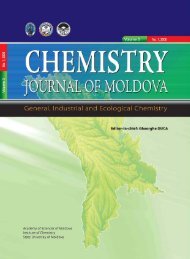stiinte med 1 2012.indd - Academia de ÅtiinÅ£e a Moldovei
stiinte med 1 2012.indd - Academia de ÅtiinÅ£e a Moldovei
stiinte med 1 2012.indd - Academia de ÅtiinÅ£e a Moldovei
Create successful ePaper yourself
Turn your PDF publications into a flip-book with our unique Google optimized e-Paper software.
290<br />
18. Liatsikos E.N., Kapoor R., Lee B., Jabbour M.,<br />
Barbalias G., Smith A. D. Angular percutaneous renal access.<br />
Multiple tracts through a single incision for staghorn<br />
calculous treatment in a single session. Eur. Urol., 2005;<br />
48: 832–837.<br />
19. Maheshwari P.N., Andankar M.G., Bansal M.,<br />
Nephrostomy tube after percutaneous nephrolithotomy:<br />
large bore or pigtail catheter? J. Endourol., 2000; 14:<br />
735–737.<br />
20. Michel M.S., Trojan L., RassweilerJ.J., Complications<br />
in Percutaneous Nephrolithotomy. European urology,<br />
2007, 51, 899–906.<br />
21. Netto Jr. N.R., Ikonomodis J., Ikari O., Claro J.A.,<br />
Comparative study of percutaneous access for staghorn<br />
calculi. Urology, 2005; 65:659–663.<br />
22. Patel R.D., Newland C., Rees Y., Major complications<br />
after percutaneous nephrostomy – lessons from a<br />
<strong>de</strong>partment audit. Clin. Radiol., 2004; 59:766–769.<br />
23. Pearle M.S., Lingeman J.E., Leveillee R., Kuo<br />
R., Preminger G.M., Nadler R.B., et al. Prospective, randomized<br />
trial comparing shock wave lithotripsy and ureteroscopy<br />
for lower pole caliceal calculi 1 cmor less. Journal<br />
of Urology, 2005; 173(6):2005–2009.<br />
24. Pietrow P.K., Auge B.K., Lallas C.D. et al., Pain<br />
after percutaneous nephrolithotomy: impact of nephrostomy<br />
tube size. J. Endourol., 2003; 17(6):411–4.<br />
25. Robert M., Drianno N., Marotta J. et al., The value<br />
of retrogra<strong>de</strong> ureterorenoscopy in the treatment of bulky<br />
kidney calculi. Prog. Urol., 1997; 7(1): 35-41.<br />
26. Segura J.W., Le Roy A.J., Percutaneous lithotripsy.<br />
Urology, 1984, XXIII, 5.<br />
27. Segura J.W., Percutaneous endourolgy. Vascular<br />
complications. World J. Urol., 1985, 3.<br />
28. Segura J.W., Patterson D.E., LeRoy A.J., et al.<br />
Percutaneous removal of kidney stones: review of 1,000<br />
cases. J. Urol., 1985; 134:1077–1081.<br />
29. Srivastava A., Singh K.J., Suri A., Vascular complications<br />
after percutaneous nephrolithotomy: are there<br />
any predictive factors? Urology, 2005; 66:38–40.<br />
30. Stoller M.L., Bolton D., St. Lezin M., Lawrence<br />
M., Percutaneous nephrolithotomy in the el<strong>de</strong>rly. Urology,<br />
1994; 44:651–654.<br />
31. Tiselius H.G., Ackerman D., Alken P. et al., Gui<strong>de</strong>lines<br />
on urolithiasis. Gui<strong>de</strong>lines, European Association<br />
of Urology, 2006; p. 1-79.<br />
Rezumat<br />
Scopul lucrării a fost analiza retrospectivă a rezultatelor<br />
NLP în ve<strong>de</strong>rea stabilirii indicaţiilor terapeutice corecte.<br />
A fost studiat un lot <strong>de</strong> 79 <strong>de</strong> pacienţi la care s-a efectuat<br />
NLP pentru litiază renală pe parcursul anului 2011.<br />
Succesul meto<strong>de</strong>i a fost <strong>de</strong> 78.5%, eşecul procedurii a fost<br />
cauzat <strong>de</strong> complicaţii intraoperatorii care au impus repetarea<br />
procedurii sau recurgerea la altă metodă <strong>de</strong> tratament.<br />
Rata complicaţiilor minore a fost <strong>de</strong> 18.5%, cele majore:<br />
perforaţie <strong>de</strong> colon şi urinom paranefral s-au întâlnit în<br />
2.52% cazuri. În concluzie, nefrolitotomia percutanată este<br />
o intervenţie indispensabilă terapiei multimodale a litiazei<br />
renale. NLP este o metodă eficientă în rezolvarea diferitelor<br />
tipuri <strong>de</strong> litiază renală, beneficiile majore ale acestei<br />
meto<strong>de</strong> miniinvazive sânt remarcate mai ales în cazurile<br />
Buletinul AŞM<br />
dificile (litiază complexă). Complicaţiile majore, <strong>de</strong>şi rare,<br />
sunt redutabile şi necesită <strong>de</strong>pistare timpurie şi acţiune fermă<br />
în cazul apariţiei lor.<br />
Summary<br />
Retrospective analysis of the results of NLP to<br />
establish the correct therapeutic indications.<br />
In the study was inclu<strong>de</strong>d 79 patients with<br />
urolithiasis un<strong>de</strong>rgoing PCNL in 2011 year. The success of<br />
the method was 78.5%, procedure failure was due<br />
to intraoperation complications and was necessary to repeat<br />
the procedure or to use another method of treatment. The<br />
rate of minor complication was 18.5%, the most difficult<br />
major complication was 2.52%: perforation of the colonum<br />
and paranephral urinoma. Conclusions: in the multimodal<br />
aproach of urolithiasis PCNL is indispensable method of<br />
treatement; PCNL is effective method in the treatement<br />
of diferent types of kidney stones, the major avantage<br />
of this miniinvasive method are important in difficult<br />
situations, (complex stones). Major complications are no so<br />
frequent, we must put im<strong>med</strong>iate diagnosis and im<strong>med</strong>iate<br />
action if this complications apears.<br />
Резюме<br />
Цель работы – pетроспективный анализ результатов<br />
ЧНЛТ, с целью определения правильных показаний к<br />
терапии. В исследование были включены 79 пациентов<br />
с мочекаменной болезнью, перенесших ЧНЛТ в 2011<br />
году. Успех метода был зафиксирован в 78.5% случаев,<br />
неудачи были связаны с интраоперационными осложнениями,<br />
которые вызвали необходимость повторения<br />
процедуры или применения других методов лечения.<br />
Частота незначительных осложнений составила 18.5%,<br />
частота серъезных осложнений, таких как: перфорация<br />
толстого кишечника и околопочечного мочевого затека,<br />
составила 2.52%. Чрескожная нефролитотомия является<br />
незаменимым методом в комплексном лечении<br />
мочекаменной болезни почек. ЧНЛТ является эффективным<br />
методом разрешения различных типов почечных<br />
камней, основные преимущества этого миниинвазивного<br />
метода зафиксированы особенно в сложных<br />
случаях (сложные камни почек). Серъезные осложнения,<br />
будучи редкими, являются значимыми и требуют<br />
ранней диагностики и решительных действий.<br />
THE ROLE OF OPEN SURGICAL<br />
TREATMENT IN STAGHORN LITHIASIS<br />
_______________________________________<br />
Andrei Galescu, doctoral study,<br />
Emil Ceban, dr., Associated professor,<br />
SUMPH “Nicolae Testemitanu”<br />
Introduction<br />
Urinary stones disease is placed on third place<br />
in urological diseases structure, which is from 10%<br />
to 40%, yielding only urinary infection and prostate<br />
pathology, representing 59.6% of all renal pathologies<br />
[1, 2].

















